Where the Maiasaurs Roam:
Why I'm Writing This Story
Other than, because it's there to be written? Well, actually, there is a story behind the story. I am a fan of dinosaurs. I have watched almost every Discovery special I've ever seen concerning dinosaurs, and I have tried to learn as much as I can, within reason. That is to say, I'm not a paleontologist: I DO have other things to do.
Having said that, I have become less and less of a fan of such stories as Jurassic Park and the like, where dinosaurs are not portrayed as animals, but rather as monsters whose only goal seems to be to kill the poor, unwitting humans who happen to stumble in their way.
So, I set out to write a story about "realistic" dinosaurs. Okay, that's next to impossible, since no one knows for sure what they acted like. But I wanted to make dinosaurs more like what I thought real animals would be like. Dinosaurs are basically the stepping stone between reptiles and birds, and so I drew some conclusions based on that. Hopefully I won't offend anyone other than Jack Horner with the way I've portrayed the dinosaurs.
I have researched this story thoroughly, to select dinosaurs that could exist in the same area at the same time. I may have fudged a bit: I can't swear that all of the dinosaurs that appear would actually have occupied the same geographical regions, but I did my best. I can say that they all existed at the same time, at least according to the sources I used.
Anyway, most of the rest of this file is dinosaur-identification information. I thought it would be helpful so that you could envision the dinosaurs, without me having to go into long-winded descriptions right inside the story. So, let's get on with the facts. (The information regarding dinosaur behavior is my opinion on how they would act only: there is nothing in the fossil record to confirm or deny my allegations.)
Oh, one final note... kind of me wimping out, but mainly it has to do with semantics. There was no such thing as "grass" in the Mesozoic Era. Having said that, there's no truly convenient term for "a bunch of low-growing plants that cover wide expanses of ground." As such, I will occasionally slip and refer to "the grass", the "grassy plain", or other such terminology. I hope you understand that I KNOW that there was no grass, and I'm not implying that they're really is grass, even in the story, so much as I'm using the term to keep from cluttering up the story with wordiness.
Dinosaurs of the Cretaceous
It is unlikely that you would ever see all of the following dinosaurs within a single story in this serial. I have included pictures, statistics, and a little bit of "character", as I see these dinosaurs, to familiarize you with them in the story. I hope this helps.
A Note: These pictures are bigger than they appear on this page. If you want a better view, save them and look at them in your favorite image viewer.
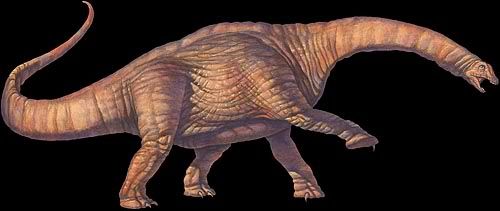
|
AlamosaurusMeans: "Alamo Lizard", named for the Ojo Alamo trading post in New MexicoHeight: 9m (28') Length: 21m (69') Weight: 30 tons (27,000 kg) Diet: Herbivore Background: The only Titanosaur in North America, and one of the last of the sauropod species surviving. This giant plant-eater's only dangerous if you happen to get in his way. |
AnatotitanMeans: "Giant Duck" One of the largest of the hadrosaurs, or "duck-billed" dinosaurs.Height: 5m (16') Length: 12m (39') Weight: 4.5 tons (4,000 kg) Diet: Herbivore Background: A large plant-eater, the anatotitan usaully walked on two legs, but could walk on all four if it had reason to. Anatotitan, like most hadrosaurs, traveled in herds, and its main purpose in life is to eat vegetation. |
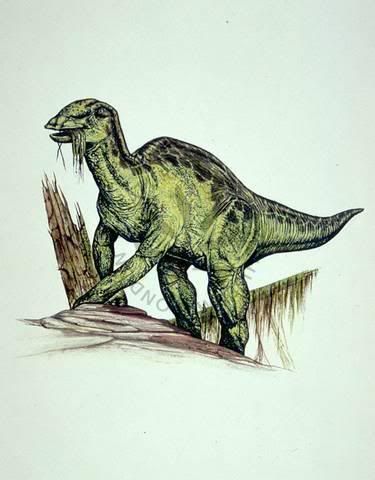
|
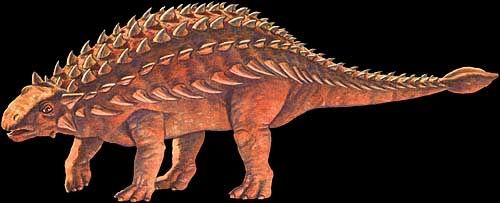
|
AnkylosaurMeans: "Fused Lizard" from the plates on its backHeight: 3.5m (11') Length: 10.5m (35') Weight: 5 tons (4,500 kg) Diet: Herbivore Background: Slow and not terribly bright, the anky, as he is known in the story, is nonetheless dangerous. He's quick-tempered, and his clubbed tail will kill almost anything. |
BambiraptorMeans: "Bambi Raider" Named, yes, for the Disney character.Height: .3m (1') Length: 1m (3') Weight: 7 lbs (3 kg) Diet: Carnivore Background: Covered with feathers, and with proto-wings on its arms, this dinosaur is the clearest indication that dinosaurs evolved into birds. These animals hunted in packs, like most raptors, using their sickle-shaped toe claw to hang onto their prey while killing it. Bambiraptors were not "ferocious evil monsters," and were too small to really harm a human, anyway, though they could certainly injure one. |
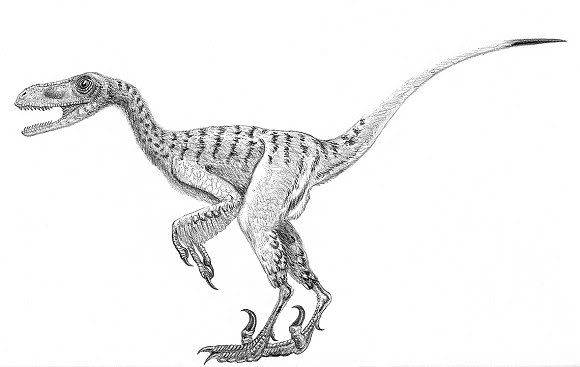
|
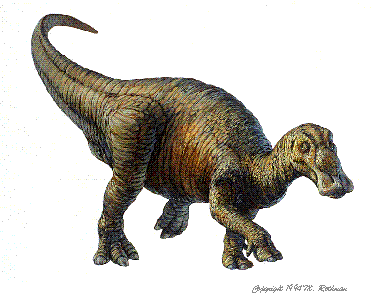
|
EdmontosaurusMeans: "Edmonton Lizard", named for the location of its discovery.Height: 6m (20') Length: 13m (45') Weight: 4 tons (3,500 kg) Diet: Herbivore Background: Related to the aforementioned anatotitan, edmontosaurus had about 1000 teeth in its mouth. A plant-eater with an attitude, you should stay away from edmontosaurus if you don't want to get hurt. |
MaiasaurusMeans: "Good Mother Lizard" so named because it appears to be smiling.Height: 4.5m (15') Length: 9m (30') Weight: 4 tons (3,500 kg) Diet: Herbivore Background: Far friendlier than its brother, edmontosaurus, the maiasaurs live in huge herds, and fiercely protect their young. Not a danger, so long as you don't threaten the kiddos, these dinos are no real threat. |
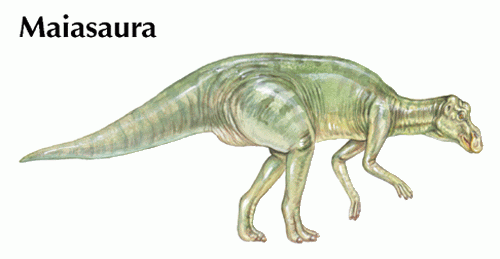
|

|
ParasaurolophusMeans: "Similar Crested Lizard", because it resembles the saurolophus.Height: 5m (16') Length: 10m (33') Weight: 4 tons (3,500 kg) Diet: Herbivore Background: Hadrosaurs were the most prominent type of dinosaurs in the Maastrichtian Age. The 'paras', as they're known, create a long, low trumpeting sound that can be heard for miles. These dinos are definitely not a threat to anyone. |
OrnithomimusMeans: "Bird Mimic", because of its resemblance to a modern ostrich.Height: 3m (9') Length: 5m (15') Weight: 300 lbs (150 kg) Diet: Carnivore/Omnivore Background: Nasty, dangerous, and will eat damn near anything. If you want to live to see the sunset, stay the hell away from ornithomimus. |
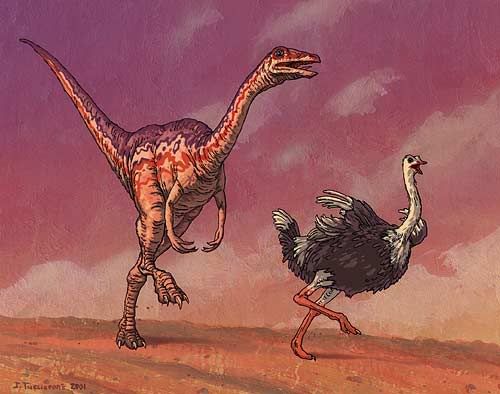
|
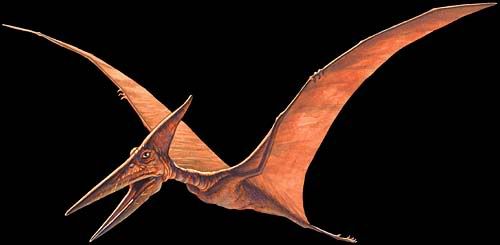
|
PteranodonMeans: "Winged and Toothless"... should be self-explanatory. :)Height: 2m (6') Length: 2m (6') Wingspan: 7m (23') Weight: 35 lbs (16 kg) Diet: Carnivore Background: This is not a dinosaur. It is a flying reptile. It feeds mainly on fish, making it a possible annoyance to humans, but not much of a threat. |
QuetzalcoatlusMeans: Named after the Aztec god, QuetzalcoatlWingspan: 12m (40') Length: 5m (15') Weight: 225 lbs (100 kg) Diet: Carnivore/Omnivore Background: Skimming the water for fish, or feeding on carrion as it can be found, the Quetzalcoatlus only represents a threat to you if you get too close. Like Pteranodon, this is not a dinosaur, but a flying reptile. |
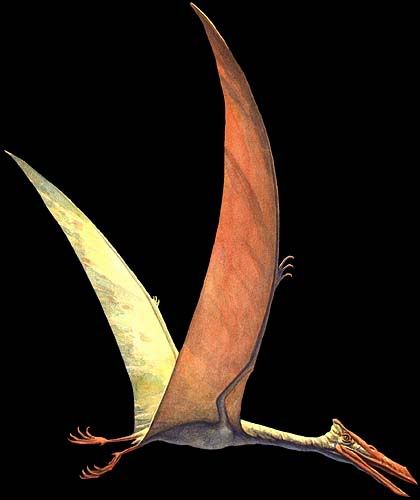
|
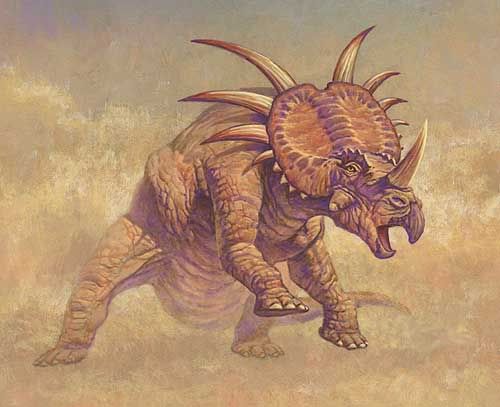
|
StyracosaurusMeans: "Spiked Lizard", from the horns on its frill.Height: 3m (9') Length: 5m (17') Weight: 3 tons (2,500 kg) Diet: Herbivore Background: Nasty as this guy looks, this relative of the triceratops has a placid disposition. Even walking among the styracosaurs will not cause undue distress. Their 'decorations' are used during mating rituals, and for self-defense, and these plant-eaters are no threat to humans. |
TriceratopsMeans: "Three-horned face" because it has three horns.Height: 3m (9') Length: 8m (26') Weight: 7 tons (6,500 kg) Diet: Herbivore Background: Unlike the styracosaur, which travels in herds, the triceratops travels in a small, family group. This larger, less pleasant cousin is not fond of being interrupted, or having anything intrude on its space. Though a plant-eater, it would be wise to go well out of your way to avoid these mean-tempered individuals. |

|
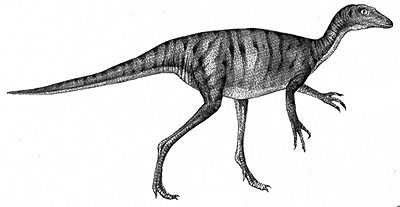
|
TroodonMeans: "Wounding Tooth", the serrated teeth on this theropod are nasty.Height: 1m (3') Length: 2m (6') Weight: 100 lbs (45 kg) Diet: Carnivore Background: Small though he is, troodon is a serious threat to humans. He is fast, agile, and the smartest dinosaur to walk the planet. He is strong and capable of ambushing prey... and he thinks you make a very nice lunch. |
Tyrannosaurus RexMeans: "Tyrant Lizard King"... oh, do you really need this explained?Height: 7m (23') Length: 15m (50') Weight: 8 tons (7,250 kg) Diet: Carnivore Background: Let's not hear any bullshit about this guy being a scavenger. He might not be the brightest of dinosaurs, but he is one of the nastiest. If you see this guy, hope he's already hunting something else, so he won't think you'd make a good snack. |
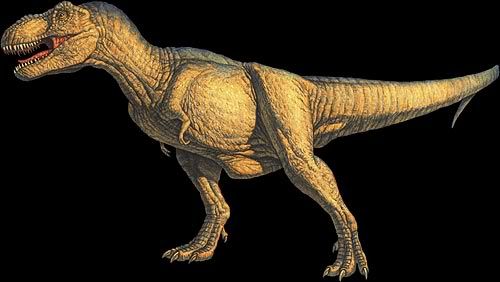
|
Resources
Like most of my stories, I have researched this one. I will admit to doing far more work on this one than most, however. Below is a linked list of the sites I used, and what I used them for. I may have forgotten one or two that I used for trivial details.
- Healthstone Hobbies - Most of the dinosaur vital stats.
- The Dinosaur Art of Joe Tucciarone - Where I got a lot of the pictures. He has lots of others. Go take a look!
- Fortean Times Article - The article that finally fully convinced me (as I have long believed) that an asteroid had nothing to do with the dinosaurs going extinct.
- Cretaceous "Hell Creek Faunal Facies"; Late Maastrichtian - Page that helped me get a lot of details about plants, and dinosaur distribution, and some other general information.
- Dinodata.net - Helped me compile the list of dinosaurs that I could possibly use in the story.
- Dinosauricon - Helped me learn about the different types of dinosaurs, thus helping me whittle down the list.
- Zoom Dinosaurs - My starting point; gave me some basic information. Also, gave me useful information about dino biology, and some information about Cretaceous plant life.
These resources were invaluable to me in trying to write a realistic, believable scenario for the dinosaurs and other animals in these stories. Any mistakes made are mine, not theirs... unless, of course, I followed their information and it turns out to be wrong. Then it's ALL THEIR FAULT! :D
I hope that you find Where the Maiasaurs Roam to be an entertaining story, more than an educational one, but if you happen to learn something, try not to be offended. :) Now that you know all you need to know about dinosaurs, please, move on to read the stories.
Where the Maiasaurs roam...
Where the rex and the troodon play...
See Pteranodons and more...
And dodge the Ankylosaur...
And the skies are not cloudy all day.